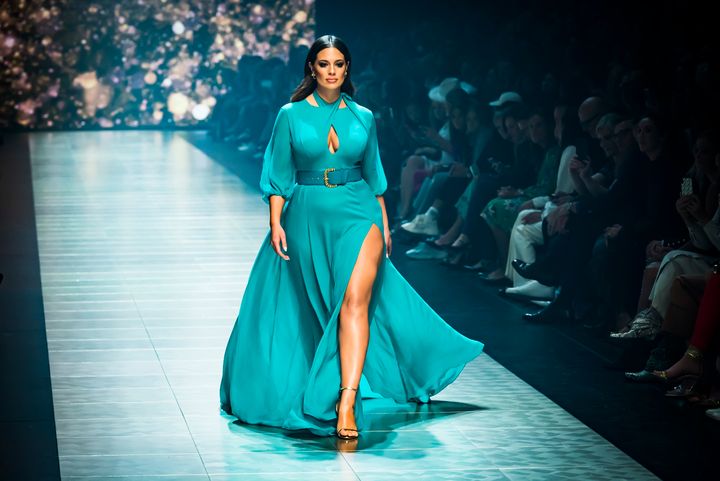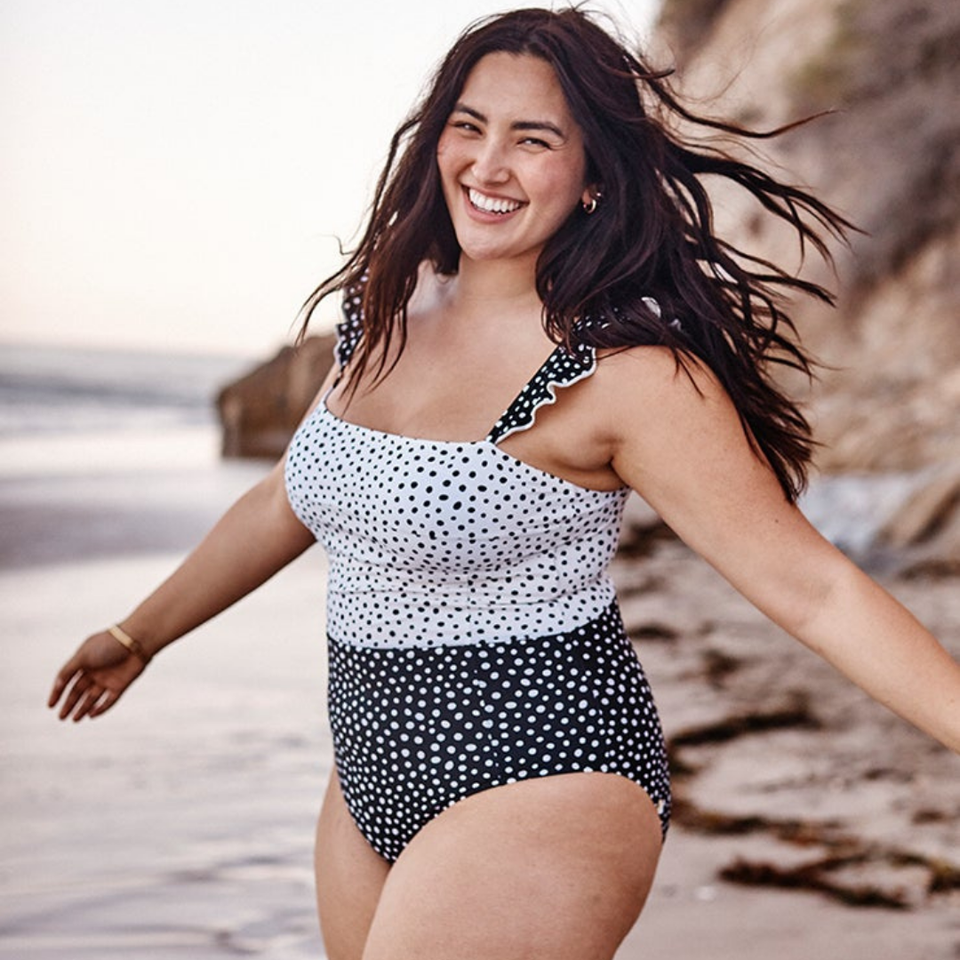
New York Fashion Week begins Friday, and after years of a demand for more body inclusivity, the industry event still has a long way to go. Although many fashion brands have made an effort to introduce plus-size clothing and models, even the crowd invited to attend doesn’t feel inclusive to many.
Blogger Chastity Garner told HuffPost that she felt like an outsider from the beginning. When she was at fashion week in 2015, she was 360 pounds and couldn’t wear any of the clothing on the runways. “What was I really attending for?” she asked. “It’s like when you want a seat at the lunch table in school. I’m a person who loves fashion and wants to be included in fashion, but I didn’t feel included at fashion week.” To Garner, this wasn’t a surprise. “You can barely shop in malls if you’re over a certain size, so I expected not to be represented at fashion week,” she said.
Instagram influencer Greivy was only invited to one New York Fashion Week show in February — for Tiffany Brown, a designer who has featured full-figured models in the past. “The PR [public relations] people are limiting the reach their client can get by making a list that isn’t inclusive,” she shared. In the past, Greivy was invited to shows for Cynthia Rowley, Libertine, Anna Sui and more designers, but this year she chose not to email PR teams to request invitations. “I knew I would just be disappointed because TikTok influencers get all the seats now. It’s ridiculous,” she said. “I know very well these TikTokers don’t reach out like I used to, either. They don’t know how or who is in charge.” Greivy sees a constant struggle to prove she belongs at fashion week: “Sometimes, designers have a few seats, but plus-size influencers are more than just a sacrifice.”
Most attendees of designer shows are dressed by the brand. However, plus-size guests are often left out of clothing pulls. “Brands are only dressing sample sizes. It’s really hard to show up and not wear the brand while everyone else is because I don’t fit the clothing,” Greivy said. “It feels like I’m not cool or like I’m a loser because I stick out.” She has noticed these brands have oversize pieces that may fit, but they don’t offer them to her in the first place. “They want their image to be a certain way, and that way is sample size,” Greivy said. “Sometimes, a jacket can or belt can fit five different sizes, but they only gift the clothes to people who are a size 2. I’ll probably get a handbag or a shoe from the brand, but that’s it.”
For DJ Ty Alexander, being left out of fashion week has become the norm. Not only did she receive no invitations this year, but the influencer hasn’t attended since 2017. “In addition to being plus size, I am also Black, so most of my existence in fashion — in the world, really — feels like I’m on the outside looking in,” she said. “There is pressure in the world to stay thin. This isn’t a fashion issue. Fashion is only mimicking what society is doing. Everything about the world is thin, and I’m afraid that will not change.”
Models are also being affected, as they are instructed to maintain their tall, thin physique for runways. Surrendering to standards proved detrimental to Nathalia Novaes’ mental health. She views the fashion industry as the catalyst for her eating disorder, a struggle she endured for seven years as a model. “I built this international career that I’m super grateful for. But I built that with a body that wasn’t really natural because I was dieting all the time,” she told HuffPost. “I was never able to relax around food. I was always hungry.”
She cited a 2014 fashion week in Brazil as a particularly toxic experience. “All the models are really focused on not gaining weight. Nobody was actually eating,” she recalled. “I remember going back to my home with this mental exhaustion and feeling of hunger. I couldn’t eat because I had all of these shows.” By the end of fashion week, Novaes would resort to binging. “I was starving myself so much. It’s a triggering environment where everyone is self-conscious,” she said.
“Inclusivity is more than just the model on the runway. It’s also the clothing that is being offered.”
- Chastity Garner, blogger
When Novaes was just a size 4, clients started to complain about her weight. “I was called a balloon,” she said. “I have big hips, and I think they’re beautiful. But I’m not like the stereotypical model that’s a straight line.” Eventually, Novaes’ work stopped completely. She dropped her agency at the time, and it was eager to let her go. “I told my agency I was leaving. They said they were relieved because I wasn’t getting any work,” Novaes said.
Models and influencers aren’t the only ones privy to industry pressures; photographers avoid shooting larger bodies, as well. “Body exclusivity has been the norm for a fairly good portion of my career,” said photographer Alvin Toro. “Everything from the runway shows to editorials, advertisements and catalog shoots have been and still are plagued with outdated beauty ‘standards.’ The 1990s brought digital image manipulation and the rise of the supermodel. With them came the unrealistic beauty standards we are still fighting against today during fashion week.”
Toro said he even fell into patterns of body exclusivity in his own shoots. “It was almost impossible to have anyone consider your work if the models did not fit the editor’s vision,” he said. “Because of the top-down way the industry works, advertising agencies and brands would adopt a similar stance.”
In an industry that still struggles to be fully body-inclusive, it is up to the models, influencers and photographers as individuals to spark change. After years of dieting, Novaes decided enough was enough. “I sent an email to my agents and said: ’OK, I’m probably going to gain weight, but I’m just not going to diet. I don’t want to hear any comments about my body anymore,’” she said.
Toro, meanwhile, has taken steps to showcase more diversity in his work. In 2019, the photographer partnered with Hungarian fashion designer Eni Hegedus-Buiron of Lulu et Gigi Couture for an editorial shoot in Paris, which featured several plus-size models and a double amputee.
However, designers often use plus-size models to check off a box and avoid criticism or controversy. As plus-size fashion became more mainstream, the industry realized it could profit by tokenizing curvy models. “Real inclusivity looks like more than a token model. It looks like more than this one girl who gets a chance to walk for a major brand,” Garner said. “Inclusivity is more than just the model on the runway. It’s also the clothing that is being offered.”
Although progress has been made, people are still excluded from fashion week because of their size. “When I became a plus-size model, I was a size 8, which is ridiculous,” Novaes said. “I didn’t get much work, because whenever [designers] want to cast someone diverse, they go for the extreme. They think, ‘OK, putting this plus-size woman in makes us inclusive.’” The model sees it as an either-or situation: You’re either plus size or you’re not, and there is no in between.
Body-inclusive efforts are seen as a rebellion against the status quo. Designers receive honorable mentions for introducing a greater size range, but there is no consideration of why those sizes weren’t present to begin with. “These brands need to do better. Just because we’re over a size 14 doesn’t mean we can’t be invited [to fashion week],” Greivy said.
